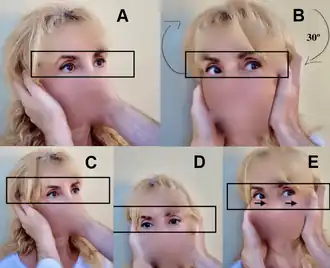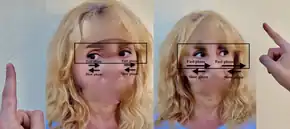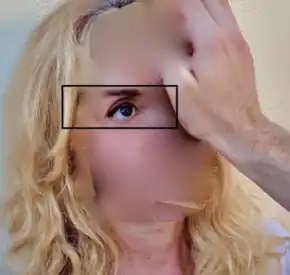HINTS test
| HINTS test | |
|---|---|
| Other names: Head impulse, nystagmus, test of skew;[1] head impulse test (HIT); HINTS exam | |
Demonstration of the HINTS test on a person without symptoms[2] | |
| Purpose | Distinguish central from peripheral causes of dizziness[3] |
HINTS test is a combination of three physical exams that are performed at the bedside in those with continuous and ongoing dizziness or vertigo with nystagmus present despite being at rest.[4][3] It involves the horizontal head impulse test, observation of nystagmus on primary gaze, and the test of skew.[5]
The test is used to help separate central causes of dizziness such as stroke, intracranial bleeding, tumors, and multiple sclerosis from peripheral causes of dizziness such as benign paroxysmal positional vertigo, vestibular neuritis, Ménière’s disease, vestibular migraine, and problems with the neck.[1]
In a peripheral dizziness there should be a positive head impulse test, one directional nystagmus that worsens when looking in the direction opposite the affected side, and no vertical adjustment of the eyes with alternately covering the eyes.[4] Otherwise there is concern for a central cause.[4]
Head impulse test

The head impulse test involves rapidly turning a person's head 30 degrees to each side while the person looks directly at the examiners nose.[1] With peripheral vertigo the eyes should move with the head and than correct with a rapid eye movement.[1] In central vertigo the person's eyes should stay fixed on the examiner.[1]
- Abnormal head impulse test, in this case due to vestibular neuritis, rest of exam normal[6]
- Negative head impulse test indicating a central cause of vertigo, in this case a posterior fossa bleed. Nystagmus was one direction and there was no skew.[7]
Observation of nystagmus

In peripheral vertigo when the person looks in the direction of the nystagmus fast phase, it increases and when the look in the opposite direction it decreases.[1] In central vertigo looking in the opposite direction results in the direction of the nystagmus changing.[1]
Test of skew

The test of skew involves alternating coverage of the eyes while the person fixes their eyes on the examiners face. In peripheral vertigo no vertical correction occurs. With central vertigo their may be a vertical correction when the eye is uncovered.
- Abnormal head impulse test, one directional nystagmus, and abnormal skew due to a central vertigo, specifically Wallenberg syndrome[8]
References
- 1 2 3 4 5 6 7 8 9 Koukoulithras, Ioannis; Drousia, Gianna; Kolokotsios, Spyridon; Plexousakis, Minas; Stamouli, Alexandra; Roussos, Charis; Xanthi, Eleana (4 August 2022). "A Holistic Approach to a Dizzy Patient: A Practical Update". Cureus. doi:10.7759/cureus.27681. PMID 36106247.
- ↑ "Demonstration of HINTS examination in a normal subject | NOVEL - Daniel Gold Collection". collections.lib.utah.edu. Archived from the original on 27 August 2021. Retrieved 28 June 2023.
- 1 2 Edlow, Jonathan A.; Carpenter, Christopher; Akhter, Murtaza; Khoujah, Danya; Marcolini, Evie; Meurer, William J.; Morrill, David; Naples, James G.; Ohle, Robert; Omron, Rodney; Sharif, Sameer; Siket, Matt; Upadhye, Suneel; e Silva, Lucas Oliveira J.; Sundberg, Etta; Tartt, Karen; Vanni, Simone; Newman‐Toker, David E.; Bellolio, Fernanda (May 2023). "Guidelines for reasonable and appropriate care in the emergency department 3 ( GRACE ‐3): Acute dizziness and vertigo in the emergency department". Academic Emergency Medicine. 30 (5): 442–486. doi:10.1111/acem.14728. PMID 37166022.
- 1 2 3 Gold, Daniel. "Demonstration of HINTS examination in a normal subject". Neuro-Ophthalmology Virtual Education Library (NOVEL): Daniel Gold Collection. Spencer S. Eccles Health Sciences Library. Archived from the original on 27 August 2021. Retrieved 20 November 2019.
- ↑ Tarnutzer, AA; Berkowitz, AL; Robinson, KA; Hsieh, YH; Newman-Toker, DE (14 June 2011). "Does my dizzy patient have a stroke? A systematic review of bedside diagnosis in acute vestibular syndrome". CMAJ : Canadian Medical Association journal / journal de l'Association medicale canadienne. 183 (9): E571-92. doi:10.1503/cmaj.100174. PMID 21576300.
- ↑ "Abnormal Head Impulse Test in Vestibular Neuritis 1 Week After Onset | NOVEL - Daniel Gold Collection". collections.lib.utah.edu. Archived from the original on 1 July 2023. Retrieved 28 June 2023.
- ↑ "Central Acute Vestibular Syndrome Due to Posterior Fossa Hemorrhage | NOVEL - Daniel Gold Collection". collections.lib.utah.edu. Archived from the original on 1 July 2023. Retrieved 28 June 2023.
- ↑ "+ HIT, + Skew, Unidirectional Nystagmus: Central Acute Vestibular Syndrome Due to Wallenberg Syndrome | NOVEL - Daniel Gold Collection". collections.lib.utah.edu. Archived from the original on 1 July 2023. Retrieved 28 June 2023.
External links
- Videos of HINTS exams Archived 2023-07-01 at the Wayback Machine